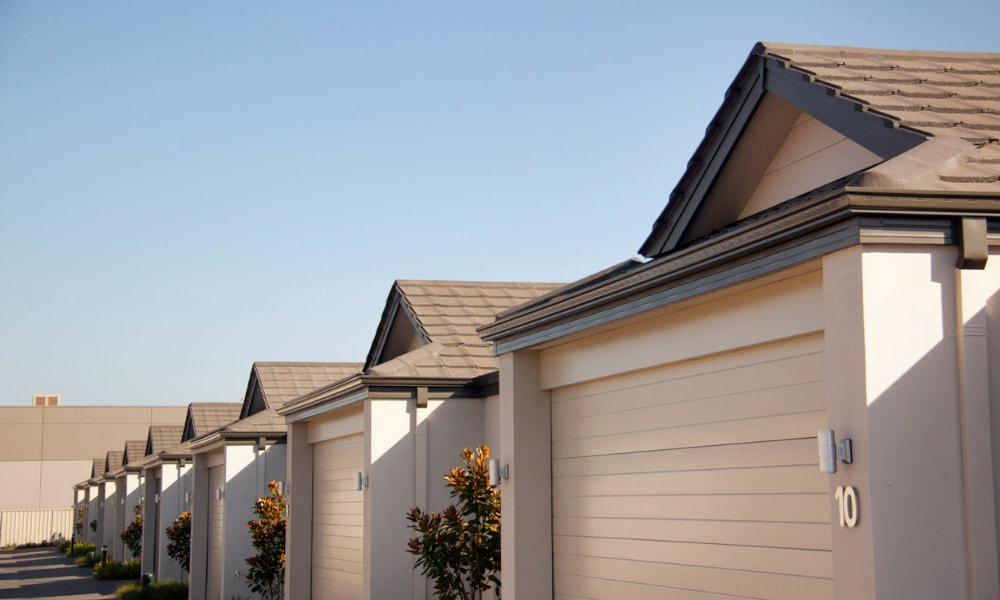|
Report author says current market “faintly echoes” that of 2007 – but there are key differences
The lifetime default risk of US-backed mortgages rose in the second quarter of 2021 as less-risky refinance loans continued to dwindle, according to the Milliman Mortgage Default Index (MMDI). The report showed that rising interest rates led to an increase in purchase loans, as refinances – which are typically viewed as lower-risk – decreased over the quarter. According to the Mortgage Bankers Association's latest survey, the refi share of mortgage activity dropped from 63.5% to 62.9%, as the 30-year fixed mortgage rate climbed to 3.1%. "We've been seeing default risk climb throughout the first half of 2021, driven primarily by increased economic and borrower risk for new purchase loans," said Jonathan Glowacki, a principal at Milliman and author of the MMDI. "And while today's housing market faintly echoes that of 2007, before the global financial crisis, we see a number of important key factors that differentiate this increase in default risk." Quarter over quarter, the default risk for purchase and refinance mortgages backed by Fannie Mae and Freddie Mac increased from 1.20% to 1.48%. The mortgage default rate for Ginnie Mae loans was up from 7.41% in the first quarter to 8.75% in the second quarter.
0 Comments
"This reality illustrates the challenging situation facing the housing market"
After two consecutive weeks of declines, US mortgage rates rose back above 3% this week, according to Freddie Mac. Freddie Mac chief economist Sam Khater said that the combination of rising inflation and consumer spending had driven a 12-basis point increase in the 30-year fixed-rate mortgage. The benchmark long-term rate averaged 3.10% for the week ending November 18. “Shoppers looking to buy a home are fueling strong demand while ongoing inventory shortages are not improving in the presence of higher home prices,” Khater said. “This reality illustrates the challenging situation facing the housing market.” “Higher inflation summons higher mortgage rates just as surely as baked beans invite ants to a picnic,” added Holden Lewis, home and mortgage specialist at NerdWallet. “The inflationary trend is pushing the 30-year fixed-rate mortgage above 3% for good.” The 15-year fixed-rate mortgage jumped from 2.27% to 2.39% week over week, while the 5-year Treasury-indexed hybrid adjustable-rate mortgage dropped 2.53% to 2.49%. They have just 36 hours.
Banks must report major cyberattacks to regulators within 36 hours if the incident is likely to disrupt their business, according to a new rule from US regulators. Any “computer security incident” that threatens a lender’s operations, services to customers or the stability of the financial system has to be disclosed to the bank’s primary government watchdog, according to a rule issued on Thursday that is set to go live on May 1. The regulation, approved by the Federal Reserve and other banking agencies, will also extend to companies that provide services to banks. Those firms will be asked to notify their bank clients as soon as possible when disruptions are expected to affect customers for more than four hours. Possible examples of incidents that firms should report include large-scale distributed denial of service attacks or a computer hack that knocks out banking operations for more than a brief period, according to the rule from the Fed, Office of the Comptroller of the Currency and Federal Deposit Insurance Corp. The 36-hour clock starts as soon as the bank is aware of an incident, according to the rule. MBA data reveals how rising rates affect mortgage demand
Rising interest rates have pushed mortgage application volume lower, according to data from the Mortgage Bankers Association’s (MBA) Weekly Mortgage Applications Survey. “Activity has been particularly sensitive to rate movements, and last week’s decline was driven by a drop in conventional and FHA refinance applications, which offset an increase in VA refinance applications,” said Joel Kan, MBA’s associate vice president of economic and industry forecasting. “All mortgage rates in MBA’s survey increased, with the 30-year fixed-rate climbing to 3.2%.” MBA’s Market Composite Index dropped 2.8% on a seasonally adjusted basis and was down by 4% on an unadjusted basis for the week ending November 12. The refinance index fell 5%, while the purchase index increased 2% week over week. “Refinance applications decreased for the seventh time in eight weeks, as mortgage rates moved higher after two weeks of declines,” Kan said. “Purchase applications increased for both conventional and government loan segments, as housing demand continues to show resiliency at a time – late fall – when homebuying activity typically slows.” Kan said the second consecutive increase in purchase applications suggests that stronger sales activity may continue in the coming weeks. The refinance share of mortgage activity went down from 63.5% to 62.9%. Meanwhile, the adjustable-rate mortgage (ARM) share of activity grew to 3.2%, the FHA share rose to 8.9%, and the VA share of total applications climbed to 10.8%. The USDA share of total applications remained unchanged at 0.5%. Is it all downhill from here?
As persistent supply chain issues continue to cause headaches for builders, new housing starts dropped for the second straight month in October after rebounding briefly in August. Stats from the Census Bureau showed that new home starts slipped 0.7% from September’s revised estimate of 1.53 million units to a seasonally adjusted annual rate of 1.52 million in October – below expectations of 1.58 million, but modestly higher than a year ago. Single-family housing starts fell 3.9% to 1.04 million – the slowest pace since August 2020 – while multifamily starts rebounded from September’s decline to 481,000 in October. “While groundbreaking on new homes slowed in October, housing permits, a leading indicator of future starts, rose, which is a good sign that home building is beginning to accelerate to keep up with the pace of household formation,” said First American chief economist Odeta Kushi. Building permits for new homes were running at a seasonally adjusted annual pace of 1.65 million, up 4% from the revised September rate of 1.59 million and 3.4% above the October 2020 rate of 1.60 million. Single-family authorizations posted a 2.7% month-over-month gain to 1.07 million, while multifamily permits were at a rate of 528,000 in October. Kelly Mangold, principal at RCLCO Real Estate Consulting, pointed out that the September new home sales figures were strong. Mangold said this “reflects market optimism and indicates that once materials and labor become readily available, we are likely to see a similar surge in starts.” “Heading into winter, it is likely that activity will be more robust than is typical for the holiday season,” she added. “Buyers are continuing to hunt for their dream home amid limited inventory levels, and builders continue to work through their backlogs.” “However, we have underbuilt new housing relative to the demand for years,” Kushi said. “Building will have to exceed household formation for some time to reduce the housing stock ‘debt’ we have accumulated. If you build it, they will buy it, and builders are taking heart. With demand for new homes still high, homebuilder confidence in the market for single-family homes rose in November. Yet, headwinds remain.” Report reveals inflation and expiration of eviction ban weigh heavily on consumers' minds.
New data from LegalShield reveals that consumers are shifting their focus away from real estate and home purchases toward accelerating inflation and a looming foreclosure crisis. For the first time in six months, LegalShield’s Housing Sales Index fell in October as prospective buyers continued to be priced out of the market. While existing home sales increased 7% to an eight-month high, sales were 2% lower than a year ago. The LegalShield Housing Construction Index also plummeted to a record low, down by 7.8 points in October. The slowdown in construction activity points to the severe shortage in available lots and is unlikely to bounce back in the short term while increasing costs and dwindling demand impact the market. “There are more pressing matters on their minds with rising inflation, federal aid, and loan and eviction moratoriums expiring,” said Jeff Bell, CEO of PPLSI, the parent company of LegalShield. Despite foreclosure filings having doubled annually, the Foreclosure Index held steady and near historically low levels in October – an effect of pandemic-related assistance programs of the government. The Consumer Stress Index also remained virtually unchanged, improving by 0.9 points month over month. However, consumers are becoming more pessimistic about the economy due to high inflation. “Higher prices for essential goods and services are reducing consumers’ spending power and, if sustained, could hamper consumers’ ability to spend elsewhere in the economy,” LegalShield wrote in the report. “Inflation-adjusted disposable income has fallen in five of the last six months, with the trend expected to continue through the holiday season. In response, consumers may turn to short-term financing tools such as credit cards and buy-now-pay-later programs, which could potentially increase financial stress in the months ahead.” Fannie Mae report shows a rise in economic concern.
Home purchase sentiment stayed flat in October as consumers remained divided about home buying and home selling conditions, as well as growing pessimism about the larger economy. Fannie Mae’s home purchase sentiment index (HPSI) inched up one point to 75.5 last month, with four of its six components posting a month-over-month increase. But, annually, the index was down 6.2 points in October. “The HPSI remained relatively flat this month, staying within the general bounds it began to set in June 2020 – following the initial shock of the pandemic to the index,” said Fannie Mae chief economist Doug Duncan. “While homebuying and home-selling sentiment remain at historically low and high levels, respectively, more consumers now expect that their personal financial situation will not improve over the next 12 months. This is particularly true among surveyed homeowners and older age groups.” In October, 30% of consumers reported it’s a good time to buy a home, while 77% said it’s a good time to sell – up from 28% and 74% last month. In addition, consumers’ expectations that mortgage rates will increase over the next 12 months also grew stronger in October, up from 51% to 55% month over month. According to Freddie Mac, the average 30-year fixed-rate mortgage declined for the first time in weeks to 3.09% for the week ending November 04. In its meeting last week, the Federal Reserve said it will not increase interest rates yet despite slowing the pace of its bond purchases. The net share of consumers who anticipate home prices will go up in the next 12 months rose four percentage points to 39% in October. Those who said they were not concerned about losing their job in the next 12 months also increased 4% to 84%. Meanwhile, the percentage of respondents who said their household income is significantly higher than a year ago dropped 3% to 23% month over month. “Consumers also reported greater concern about the direction of the economy, with ‘right track’ sentiment reaching its lowest level since October 2013,” Duncan said. “We believe the uptick in negative economic sentiment is likely a function of ongoing supply chain disruptions and inflation concerns. However, while economic uncertainty could potentially dampen mortgage demand over the longer term, we believe current market conditions remain conducive to home purchase activity, as demand for homes continues to far outstrip the supply available for sale.” Number of vacant residential properties down, but foreclosure activity "stands at a precipice" and "already on the upswing", warns report.
There are more than 1.3 million ‘zombie’ homes in the US - with New York state having the highest number of residential properties sitting vacant due to foreclosure notices, according to a new report by property analytics firm, ATTOM. A ‘zombie’ property is a home left vacant by homeowners who have defaulted on their mortgage and expect to lose it in the pending foreclosure. However, the property title remains in the homeowner’s name along with all financial responsibilities. A total of 1,312,410 homes, representing 1.3% of the housing market – the equivalent of one in 75 residential properties – sit vacant and are in foreclosure status across the country, the report said. The fourth-quarter Vacant Property and Zombie Foreclosure report examined county tax assessor data for some 99 million residential properties for vacancy, divided into foreclosure and owner-occupancy status. Only metropolitan areas with at least 100,000 residential properties as well as counties with at least 50,000 such properties were included in the report. Six of the seven states with the highest number of zombie foreclosures are in the Northeast and Midwest, while New York continues to have “the highest number of zombie properties in the US” (2,049 in Q4), followed by Ohio (925) and Florida (907). Significantly, ATTOM’s report also revealed that the number of residential properties in the process of foreclosure stands at 223,256 – up by 3.6% from the third quarter of 2021 and up by 11.6% compared to the same period last year. However, among pre-foreclosure properties, a total of 7,432 residential properties facing possible foreclosure in the US were vacated by their owners in the fourth quarter of 2021 – down quarterly by 1.4% from 7,538 and annually by 2.4% (7,612) for the fourth quarter of 2020. The number was down quarter over quarter as well as year over year in 25 states. The portion of pre-foreclosure properties that have been abandoned into zombie status also dropped slightly from 3.5% in the third quarter of 2021 to 3.3% in the fourth quarter. ATTOM stressed that out of the country’s total stock of 98.8 million residential properties, the portion represented by zombie foreclosures “remains miniscule”. The report said: “Just one of every 13,292 homes in the fourth quarter are vacant and in foreclosure, down from one in 13,060 in the third quarter of 2021 and one in 13,074 in the fourth quarter of last year.” It added that “for the moment”, the fourth-quarter zombie foreclosure numbers showed that the decade-long housing market boom “continues marching ahead”, despite the ongoing economic threat of the pandemic. However, it warned that “the foreclosure scenario stands at a precipice”, with the number of zombie properties “likely to increase over the coming year”. It added: “That’s because lenders can resume taking back properties from homeowners who fell far behind on loan payments during the pandemic, following the recent end of a 15-month foreclosure moratorium that affected most mortgage payers.” Much of that will depend on how many delinquent homeowners will be able to work out repayment plans, the report pointed out. Todd Teta, chief product officer with ATTOM said: “Zombie foreclosures are in a holding pattern this quarter – at least for now. They’re still totally off the radar screen in most parts of the country, with none in most neighborhoods. “But that’s probably going to change soon because lenders can now return to court and take back properties from owners who can’t keep up on their mortgage payments. Foreclosure activity already is on the upswing. So, depending on how fast cases wind through the courts, it’s probably just a matter of time before zombie properties begin creeping back into the mix.” Rick Sharga, executive vice president at RealtyTrac, an ATTOM company, added a caveat, saying: “Market dynamics – strong demand coupled with historically low inventory of homes for sale – suggest that we shouldn’t see a significant increase in zombie foreclosure properties anytime soon, even with foreclosure activity increasing. “Most financially-distressed homeowners should be able to sell their home rather than go through a lengthy foreclosure process where they’d ultimately abandon the property.” In response to the report Craig Torrance, CEO of Mortgage Contracting Services (MCS), which specializes in foreclosures and the inspection and maintenance of these types of properties, told MPA: “The pandemic triggered a great deal of confusion and inactivity in the foreclosure market that is just beginning to work itself out. We expect increased movement across the industry through Q1 and Q2 next year.” Up to 25% of workforce to lose jobs following $422 million loss.
Online real estate firm Zillow has announced it will be closing down its ‘Offers’ homebuying side of the business following disappointing third quarter results. Up to 25% of the workforce will be laid off as a result, prompting Zillow CEO Rich Barton to describe the decision as “a heavy, heavy thing” during an interview with news channel, CNBC. In the company’s earnings report, it emerged that Offers made a $422 million loss during Q3, offsetting Zillow’s $1.17 billion increase in revenue during the same period. Following the announcement, shares in Zillow plunged by about 10% for the year as of Tuesday’s close. The demise of the company also means that Zillow will be looking to sell about 7,000 homes for around $2.8 billion, according to reports. The decision, announced on Tuesday (November 2), came just two weeks after the Seattle-based company revealed that Offers would no longer sign new contracts to buy homes for the rest of 2021. A visibly shaken Barton blamed “the unpredictability in forecasting home prices” as one of the primary reasons for winding the company down, adding that “continuing to scale Zillow Offers would result in too much earnings and balance-sheet volatility”. He said: “This was a necessary decision. We just determined that being an iBuyer was too risky, too volatile and ultimately addressed too few customers.” The collapse of Zillow’s homebuying business has prompted questions about the viability of a model that relied heavily on relatively small profit margins and very short hold times. By Barton’s own admission, predicting the cost of a home six months into the future was made doubly hard because of the pandemic, which froze the market up initially and was then followed by a growth rate “that we never before witnessed in history”. Barton insisted that Zillow was “not in a fire-sale move” to offload the homes, which he described as “real assets”, adding that inventory “will be wound down in an orderly way”. However, he went on to admit on TV that the company was in a “big hurry” to get them renovated and back on the market. Zillow bought a total of 3,805 houses in the second quarter and managed to sell 2,086 units during that period. Offers’ fix and flip business was launched in December 2019, offering to buy homes for cash quickly with the added attraction for buyers that they could avoid time-consuming bids and other issues normally related to selling a home, including having to undertake extensive renovations. After buying a home, Zillow readied the property for sale, undertaking minor improvements such as adding a fresh coat of paint and servicing HVAC units, before listing the home on the open market. However, the company was unable to make a profit and struggled to have enough margin to cover all the extra costs related to maintenance, sales and marketing expenses after purchasing the home. In response to the news, Kate Wood, home and mortgage expert at fintech company NerdWallet, said sellers had less need for iBuyers currently as there were “plenty of homebuyers still out there competing for limited inventory”. She said: “iBuyers' success comes from volume and speed, so it's not especially surprising that this type of sellers' market presents challenges for that business model.” Broker Yury Shraybman at Philly-based Innovative Mortgage Brokers said he believed Zillow had “got in way over their heads” as there were still many unknowns surrounding iBuying. He said: “Real estate investing is not easy, regardless of whether you are doing a quick flip or long-term investing, because there are a lot of unknowns. “A lot of times investors don’t know what they don’t know. When they find out, it’s too late as there are extra repairs or additional costs that were not originally estimated for.” He said the sudden addition of 7,000 homes for sale would be “insignificant”, as the figure represented an increase of only 1% to the housing market, but he understood that more than 60% of Zillow’s homes might be sold for less than their purchase price in some parts of the country, including Phoenix, where homes have experienced a 23.5% year-over-year median price increase. Find out how the ongoing supply challenges affected prices in September.
Annual home prices in September rose 18% from a year ago as housing shortages continue to accelerate price gains. According to CoreLogic, September home prices nudged up by 18% year over year and up by 1.1% month over month. High prices are the result of high demand for home buying and low supply levels for entry-level homes – which are pricing out many potential first-time buyers. As the pandemic drags on, millennials continue to search for homes in more affordable metros, typically in the suburbs or exurbs, where property prices and population density are lower and single-family detached housing more common. “The pandemic led prospective buyers to seek detached homes in communities with lower population density, such as suburbs and exurbs,” said Frank Martell, president and CEO of CoreLogic. “As we head into 2022, we expect some moderation in the current pattern of flight away from urban cores as the pandemic wanes.” In September, home price growth of detached properties (19.6%) was 7.4% higher than that of attached properties (12.2%). Twin Falls, Idaho, posted the highest year-over-year price gain at 36.3%. At the state level, Idaho experienced the strongest price appreciation at 30.1%. Arizona and Utah followed at 29.6% and 26.2%, respectively. CoreLogic’s HPI forecast projects home price gains to slow to a 1.9% pace by September 2022, as home buying activity continues to decline due to ongoing affordability issues. |
|
- iMove Chicago
- Real Estate School
-
Laws
-
CRLTO
>
- 5-12-010 Title, Purpose And Scope.
- 5-12-020 Exclusions.
- 5-12-030 Definitions.
- 5-12-040 Tenant Responsibilities.
- 5-12-050 Landlord’s Right Of Access.
- 5-12-060 Remedies For Improper Denial Of Access.
- 5-12-070 Landlord’s Responsibility To Maintain.
- 5-12-080 Security Deposits.
- 5-12-081 Interest Rate On Security Deposits.
- 5-12-082 Interest Rate Notification.
- 5-12-090 Identification Of Owner And Agents.
- 5-12-095 Tenants’ Notification of Foreclosure Action.
- 5-12-100 Notice Of Conditions Affecting Habitability.
- 5-12-110 Tenant Remedies.
- 5-12-120 Subleases.
- 5-12-130 Landlord Remedies.
- 5-12-140 Rental Agreement.
- 5-12-150 Prohibition On Retaliatory Conduct By Landlord.
- 5-12-160 Prohibition On Interruption Of Tenant Occupancy By Landlord.
- 5-12-170 Summary Of Ordinance Attached To Rental Agreement.
- 5-12-180 Attorney’s Fees.
- 5-12-190 Rights And Remedies Under Other Laws.
- 5-12-200 Severability.
- Illinois Eviction Law (Forcible Entry And Detainer)
- Illinois Security Deposit Return Act
-
CRLTO
>
- Today's Cool Thing
- Social Media












